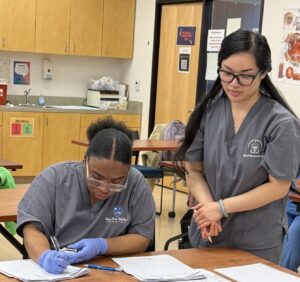We offer Medical Assisting classes year-round, so you can start when it’s convenient for you. Learn more about our program today!
Class Calendar | Call admissions on 415-943-2028
Find Phlebotomy Technician and EKG Technician training at BAMA Institute
Class Calendar | Call admissions on 415-943-2028

If you’ve ever wondered, what is a medical assistant doing each day, you’re not alone. Medical assistants play a vital role in today’s healthcare system, but many people don’t realize how diverse and hands-on their responsibilities truly are. Whether in a clinic, hospital, or private practice, medical assistants keep healthcare facilities running smoothly and efficiently.
Let’s take a closer look at what the average day of a medical assistant really looks like.
The day often begins before the first patient arrives. Medical assistants are responsible for prepping exam rooms, restocking medical supplies, sanitizing equipment, and reviewing the daily schedule. This preparation ensures that the healthcare team is ready to deliver care without delays.
During this time, they may also check voicemails or messages, return patient calls, and review lab results or physician notes to anticipate any special needs for the day.
When patients begin arriving, medical assistants take on one of their most visible roles—welcoming and preparing them for their appointments. This includes:
Medical assistants often serve as the bridge between patient and provider, ensuring accurate communication and a smooth visit.
Once the healthcare provider steps into the exam room, the medical assistant shifts into a support role. They may hand instruments to the doctor, assist during minor procedures, or collect specimens for lab tests. Medical assistants with the proper training may also administer injections, perform blood draws, or perform EKGs.
This hands-on support allows doctors and nurses to focus on diagnosing and treating patients while trusting that the workflow behind the scenes is handled competently.
Not all of a medical assistant’s work is clinical. Administrative tasks are another crucial part of the job. These can include:
So, what is a medical assistant without strong organizational skills? They must juggle multiple roles with professionalism, accuracy, and compassion.
As the day winds down, medical assistants tidy up exam rooms, dispose of biohazard materials properly, and ensure patient records are updated. They may also call patients with test results or send out appointment reminders for the next day.
Ultimately, what is a medical assistant if not a cornerstone of patient care? They balance technical skills, medical knowledge, and a compassionate bedside manner. Their daily routine might vary by setting, but their impact remains consistent—making healthcare more accessible, efficient, and personal.
Ready to take the first step toward becoming a medical assistant?
Book a virtual appointment with our admissions team today to learn more about Bay Area Medical Academy’s 3-in-1 Medical Assistant with Phlebotomy and EKG Program. Our comprehensive training prepares you for multiple certifications, hands-on externships, and a meaningful career in just a matter of months. Let’s talk about your future in healthcare—schedule your appointment now!
"*" indicates required fields
Our career-oriented program gives you hands-on, real-world training and ongoing support for your long-term goals.
For more information on BAMA's medical assisting and phlebotomy degree programs, contact us today!
BAMA: The Bay Area's best career-oriented healthcare traning
© 2024 Bay Area Medical Academy. All Rights Reserved. Website by WindsAndWater